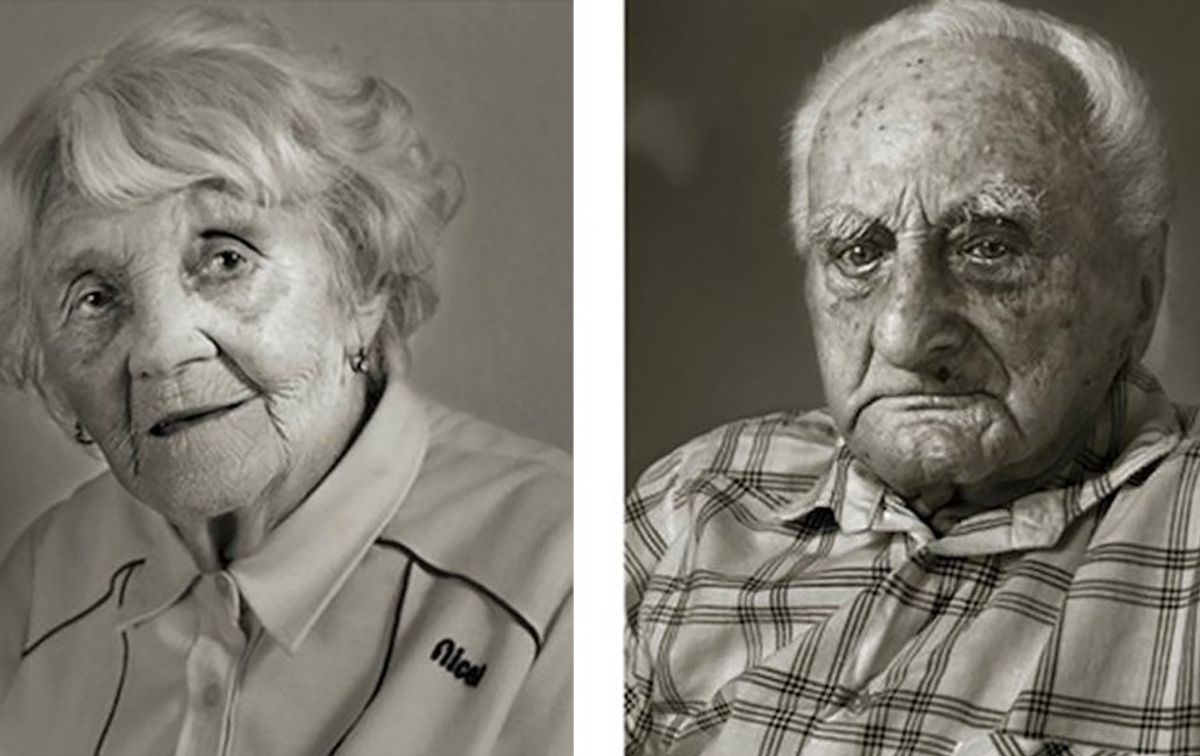13 side-by-side portraits of people over 100 with their younger selves
These powerful before-and-after photos reveal just how beautiful aging can be.

Jan Langer's incredible photos are timeless.
Czech photographer Jan Langer's portrait series "Faces of Century" shows them in a different light: as human beings aged by years of experience, but at their deepest level, unchanged by the passing of time. In the series, Langer juxtaposes his portraits with another portrait of the subject from decades earlier. He recreates the original pose and lighting as closely as he can — he wants us to see them not just as they are now, but how they have and haven't changed over time. That is the key to the series.
These are the rare faces of people who have lived through two world wars, a cavalcade of regimes, and the rush of advancements in modern life. These photos, and the stories of the lives lived by the people in them, show not only the beauty of aging, but how even as we age, we still remain essentially ourselves.
1. Prokop Vejdělek, at age 22 and 101

All photos by Jan Langer.
Vejdělek is a former metallurgical engineer who will never forget the taste of warm fresh goat's milk.
2. Bedřiška Köhlerová, at age 26 and 103

Originally born in Merano, Italy, Köhlerová wishes to visit Italy one more time.
3. Ludvík Chybík, at age 20 and 102

Chybík is a former postal carrier and says he will never forget the route he worked every day.
4. Vincenc Jetelina, at age 30 and 105

Jetelina spent eight years in prison after World War II. Now, he just wants to live the rest of his life in peace.
5. Marie Fejfarová, at age 101
Fejfarová burned all her material memories, including old photographs, when she decided to move to a long-term care facility. She lived a dramatic life, hiding from the Nazis and then the Russians, but eventually she was able to travel the world with her husband. Her experiences show there's no such thing as too late in life to start a new chapter.
6. Antonín Kovář, at age 25 and 102

Kovář is a former musician whose daughter comes to visit him every day. He wishes to play the clarinet once more.
7. Anna Vašinová, at age 22 and 102

Vašinová will always remember the day her husband was taken away by the Nazis. She wishes to be reunited with him after death.
8. Stanislav Spáčil, at age 17 and 102

Spáčil was an electrical engineer throughout his life and thinks that it's too early in his life to think about the past.
9. Anna Pochobradská, at age 30 and 100

Pochobradská was a farmer. She now lives a quiet life and is thankful that her daughter visits her every weekend.
10. Antonín Baldrman, at age 17 and 101

Baldrman was a clerk early in life and keeps up with current events by reading the newspaper.
11. Marie Burešová, at age 23 and 101

Burešová loves talking to her family and wishes to have them all together again.
12. Vlasta Čížková, at age 23 and 101

Čížková cooked in the dining room at the airport in the small village of Vodochody. She'll never forget reciting her own poetry at wedding ceremonies.
13. Ludmila Vysloužilová, at age 23 and 101

Vysloužilová stays active every day by chopping wood, shoveling snow, and doing work around her house.
The photographer Langer was initially inspired to document the lives of elderly people because of what he saw as the media's lack of coverage of them. He decided to focus on people over the age of 100 — a very rare demographic indeed. The 2010 U.S. Census reported only 53,364 centenarians, which is only 0.19% of the population of people 70 years or older.
“One should live every single moment according to their best knowledge and conscience because one day we will see clearly what has a real value," Langer says of what he learned from his subjects while photographing them.
The series was originally part of a story that Langer did for the Czech news outlet aktuálně.cz. You can see more photos from the portrait sessions by following the link.
This article originally appeared seven years ago.
- Doctor still working at 100 - Upworthy ›
- Andie MacDowell—what we can all learn about beauty and age from the gray hair movement - Upworthy ›
- Isaiah Garza takes a 100-year-old veteran to Disneyland - Upworthy ›
- Woman is surprised to find out she's turning 100 years old - Upworthy ›
- 104-year-old woman breaks world skydiving record - Upworthy ›
- 99-year-old swimmer just shattered a centenarian swim record - Upworthy ›
- People over 100 share their simple secrets to living the best life - Upworthy ›

